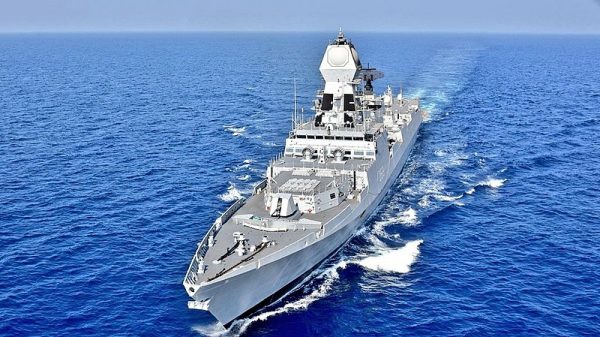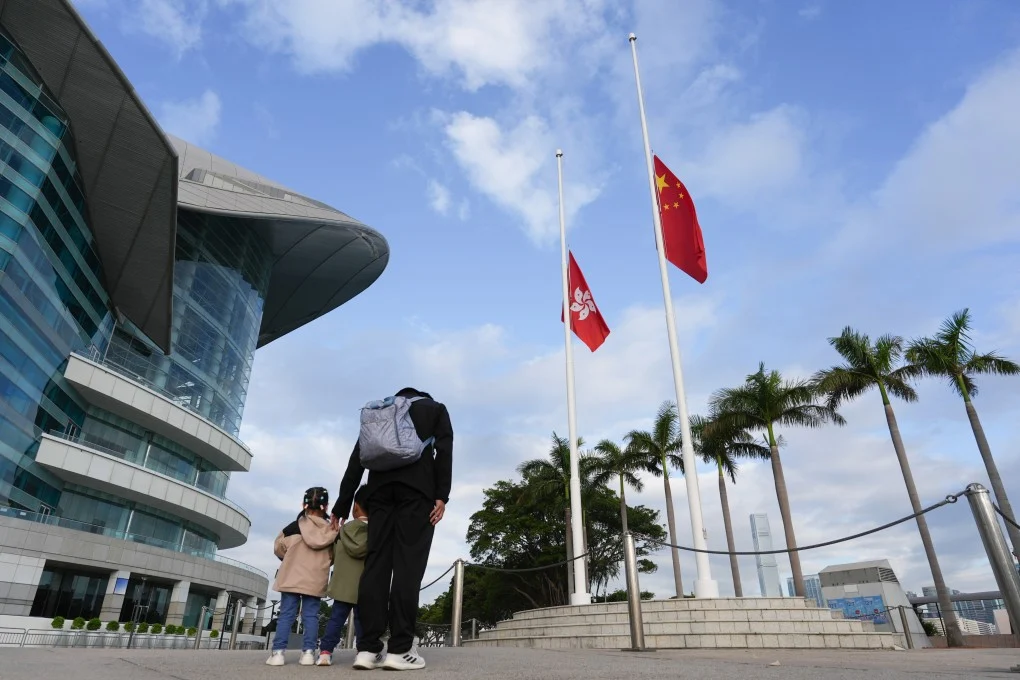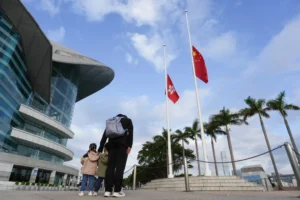A Tale of 2 Navies: India and China’s Current Carrier and Escort Procurement
This is part two of a three-part series reviewing Indian and Chinese carrier procurement. Part one can be found here.
IAC-2 and 003
The Indian Navy’s procurement of its first indigenously built aircraft carrier, INS Vikrant (or IAC-1), was always intended to be followed by a second indigenous carrier, sometimes called INS Vishal (or IAC-2). A three-carrier fleet including INS Vikramaditya, INS Vikrant, and INS Vishal was proposed to allow the Indian Navy to station one carrier on each of its western and eastern seaboard, with a third carrier to cycle through maintenance. However, no decision to buy a third carrier has yet been made, as of this writing in August 2021, nor has a definitive design and configuration been publicly declared.
Initial planning for IAC-2 began in the early 2010s, and in the intervening decade, a number of design considerations and subsystems have been floated. The size of the IAC-2 has been suggested to displace 65,000 tons at full; the desired aircraft launch method has been floated as using electromagnetic catapults (through the purchase of the U.S. EMALS system); and propulsion had initially considered nuclear power but subsequently considered conventional propulsion in an integrated electric arrangement. Various foreign ship designers may have been consulted in the IN’s work on IAC-2, and there have even been some media reports suggesting that India was seeking to use the design of the British Queen Elizabeth-class carrier as the basis of IAC-2.
However, none of these competing characteristics have yet been confirmed as traits of the eventual final INS Vishal, because the Indian Navy has yet to decide whether it wants to buy a third aircraft carrier in the foreseeable future. Given the scale of financial, industry, and manpower investment involved in operating an aircraft carrier, procurement of such vessels is not done on a whim, and for the Indian Navy, alternative naval procurement such as submarines and nuclear submarines might prove to be higher on the list of priorities.
Enjoying this article? Click here to subscribe for full access. Just $5 a month.
Therefore, a third Indian aircraft carrier is not expected to emerge in the immediate future, and it is unknown what such an aircraft carrier will look like if or when it arrives. IAC-2 could conceivably be a 65,000 ton CATOBAR ship with integrated electric propulsion, which would be a significantly more capable carrier than IAC-1, INS Vikrant. However, such a larger and more complex ship would also present corresponding risks of delay. Less ambitious designs, such as an enlarged STOBAR ship following from the design of INS Vikrant, might prove to be a more conservative but attractive ship. But ultimately, without a clear procurement decision from the IN, it is impossible at this point to determine what IAC-2 may look like.
In the unlikely event that the IN made a snap decision in 2021 to start fabrication on a conservative IAC-2 design as soon as possible, the lengthy 13-14 years taken for INS Vikrant to proceed from laying down to commissioning suggests it is very unlikely that a third Indian carrier will enter service before the early 2030s.
Diplomat Brief Weekly Newsletter N Get briefed on the story of the week, and developing stories to watch across the Asia-Pacific. Get the Newsletter
By contrast, the People’s Liberation Army Navy (PLAN)’s pursuit of its third aircraft carrier and second indigenous carrier, the conventionally powered CATOBAR carrier, 003, has been somewhat brisker, with a minimal pause between its second aircraft carrier and first indigenous carrier CV-17 Shandong. I have covered the history of carrier 003 in prior articles, and the current understanding of 003 has not significantly changed from those pieces. A conventionally powered CATOBAR carrier was credibly rumored in PLA watching circles as early as the early 2010s, at the time spoken of with a displacement of around 80,000 tons full. Rumors continued to escalate and coalesce, with consensus that the carrier would be designated 003, that it would be equipped with EM catapults, and that its construction would be at Jiangnan Changxing shipyard in Shanghai.
Initial pictures of carrier hull modules emerged at that very shipyard in mid-2018. From there, close tracking of the ship’s progression by civilian photographers and satellite imagery has confirmed various milestones of construction: Hull modules were moved from their fabrication area to drydock likely in May 2020, with module integration and flight deck installation occurring over the following year, completing the overall outline of the flight deck and reaching near structural completion around mid-June 2021. Installation of its island occurred on July 1, 2021, providing a view close to the ship’s final complete profile on the centennial anniversary of the Chinese Communist Party.
Progressive multi-source imagery of carrier 003 also allowed a number of other predictions and dimensions to be confirmed. The ship’s waterline beam was estimated to be approximately 40 meters, with an overall flight deck length approaching 320 meters, a maximal flight deck width of between 78 to 80 meters, a continuous main flight deck width about 72 to 74 meters, and an island deck footprint length of about 40 meters, all of which corresponds to past rumors of the ship displacing some 80,000-85,000 tons full. The end result is a ship significantly larger in overall size and flight deck than CV-16/CV-17 while enjoying a smaller island. Imagery of the 003’s internal propulsion arrangement and the presence of a large exhaust on its island also confirm its propulsion as conventional in nature, which was never truly in doubt.
Progression and completion of the flight deck also confirmed the carrier would be equipped with three catapults, two on the bow and one on the waist. While the type of catapults cannot be ascertained at this time based off imagery alone, the long-term consistent rumors of 003 using EM catapults necessarily means at this stage that it is most accurate to project the catapults will be EM in nature rather than steam, until proven otherwise. After all, the other predictions of the ship’s characteristics have since proven true.
Based on current progress, carrier 003 might be launched between late 2021 to early 2022, followed by two to three years of fitting out and sea trials, before entry into service around 2025, though these remain subject to change as new developments are confirmed.
Therefore, based on current projections of carrier procurement, by the end of 2030 and going into the early 2030s, the IN will almost certainly remain with two carriers in service (INS Vikramaditya and INS Vikrant), while the PLAN will have at least three carriers in service (CV-16 Liaoning, CV-17 Shandong, and carrier 003, likely to be designated CV-18). At this stage it is unknown when the PLAN will procure further carriers after the presently under construction 003. Rumors have suggested additional 003 pattern carriers will be procured before the PLAN proceeds with a nuclear-powered carrier, but it is unknown when work on those ships may begin or how many will be built. Depending on the scale of production, the PLAN could end up with anywhere between a fleet of three (minimum) to six (maximum) carriers in service by 2030.
Comparing the Escort Forces
Every aircraft carrier requires a surface combatant escort, usually composed of destroyers and frigates. The escort capability of a navy depends on the total number and appropriate capability of such destroyers and frigates in a navy’s overall order of battle. A greater number of appropriately capable surface combatants provides flexibility to further augment their carrier’s escort force, or to create additional surface groups to conduct additional taskings during peacetime and wartime. Anti-air warfare (AAW) and anti-submarine warfare (ASW) are the most important taskings of a carrier’s escorts, though escorts often retain a credible anti-surface (ASuW) capability as well. AAW is arguably the most important mission of escorts, and within most navies, the ships capable of performing higher-end AAW tasks are often identifiable by the presence of a modern phased array radar (PAR) system as well as a vertical launching system (VLS) capable of launching surface-to-air missiles (SAMs) with at least an area air defense range (at least 40 kilometers).
Enjoying this article? Click here to subscribe for full access. Just $5 a month.
At time of writing, the Indian Navy fields eight destroyers in service, composed of three Kolkata-class (7,500 tons full), three Delhi-class (6,200 tons), and two Rajput-class (5,000 tons) destroyers. Four Visakhapatnam-class destroyers (iterative improvements of the Kolkata class) are intended to be commissioned by 2025, with the first of these aiming to enter service later this year. Of these destroyers, only the Kolkata class and Visakhapatnam class are equipped with a modern PAR and a VLS area air defense SAM, in the form of the Israeli MF-STAR AESA and a complement of 32 VLS launched Israeli-Indian Barak 8 SAMs with a current range of 100 kilometers.
The IN also fields 13 frigates in service, composed of three Shivalik-class (6,800 tons), six Talwar-class (4,000 tons), three Brahmaputra-class (3,800 tons), and one Godavari-class (3,800 tons). None of the IN’s current in-service frigates are equipped with a contemporary PAR system or a VLS launched SAM of at least medium range (40 kilometers), as the most capable AAW system aboard these ships is the Russian Fregat radar and Shtil-1 arm launched SAM system in the Shivalik and Talwar classes.
However, the IN is procuring seven Nilgiri-class frigates (significant improvements of the Shivalik class) with the same MF-STAR and Barak 8 system as the Kolkata and Visakhapatnam destroyers. The first of this new class may enter service in 2022, with a goal for all seven to be commissioned by 2025. A further four improved Talwar-class frigates will also be purchased from Russia, which will replace the arm launched Shtil-1 with a VLS equivalent. It is worth noting that the Shivalik- and Nilgiri-class frigates displace 6,800 tons at full, and are only a few hundred tons lighter than various destroyer classes around the world as well as the IN’s own Kolkata and Visakhapatnam class destroyers – though the Shivalik-class frigate’s impressive displacement does not correspond to modern and capable AAW capability.
To summarize the Indian Navy’s escorts, the current fleet of escorts is composed of 21 ships – eight destroyers and 13 frigates – of which only the three Kolkata-class destroyers field high-end AAW capabilities that include both a modern PAR and VLS-launched area air defense SAMs. In fact, of the remaining 18 in-service ships, none of those are equipped with a VLS area air defense SAM or a modern PAR. This fleet of 21 escorts will grow to 36 ships, including 12 destroyers and 24 frigates, by the end of 2025, if production goes to plan and if none of the older ships are retired. Of these 36 ships, the seven Kolkata- and Visakhapatnam-class destroyers and the seven Nilgiri-class large frigates will boast a high-end AAW capability, marking 14 high-end AAW-capable multirole destroyers and large frigates. The four new Talwar-class frigates will also augment the fleet by featuring at least a VLS launched medium-range SAM capability.
As for the Chinese navy, as of the time of writing, the PLAN fields 36 destroyers in service, composed of 19 052Ds (7,000 tons full), six 052Cs (7,000 tons), two 051Cs (7,000 tons), two 052Bs (6,800 tons), one 051B (7,000 tons), four Sovremenny-class (8,000 tons), and two 052s (5,000 tons). An additional six 052Ds are in the water in fitting out, all of which are likely to enter service by the beginning of 2023. Of these destroyer classes, the 052Ds and 052Cs are equipped with a modern PAR and VLS-launched area air defense SAM capability by virtue of their Type 346/A family AESAs and HQ-9 long range SAMs (with the 052D being capable of launching additional smaller and larger SAMs as they are developed, thanks to its universal VLS). Additionally, the two 051Cs, one 051B, and two overhauled Sovremenny-class destroyers offer VLS-launched area air defense SAMs but lack modern PARs.
However, beyond destroyers, the PLAN also fields a larger category of surface combatant, the 055 class. This ship class displaces 13,000 tons full, significantly larger than almost all destroyer classes in the world today save for a few, and due to its size, armament, and sensors, it has been described as a cruiser by some overseas commentators and government agencies, though the PLAN refers it to as a large destroyer. Regardless of designation, it goes without saying that the 055 would be a key component of any carrier escort force, and this has been confirmed by recent PLAN carrier exercises featuring an escort flotilla led by an 055. At present, three 055s are in service, with a further five in the water likely to all enter service by 2023. The 055 more than fulfills the criteria of meeting the high end AAW threshold, with qualitative capabilities and quantitative magazine size significantly greater than that of the PLAN’s next most capable surface combatant, the 052D.
In terms of frigates, the PLAN fields 30 frigates in service, all of which are 054As (4,000 tons full). Additional 054As are currently under construction, and are likely to start to enter service from late 2022, perhaps averaging two hulls per year. All of these ships lack a modern PAR, but are equipped with a VLS that features area air defense SAMs in the form of HQ-16s.
To summarize the PLAN’s escorts, the current fleet of escorts is composed of 69 ships – three large destroyers, 36 destroyers, and 30 frigates. Of these escorts, 28 ships feature at least a high-end AAW capability equipped with both PAR and VLS-launched area air defense SAMs, made up of the three 055s large destroyers, 19 052Ds, and six 052Cs. Another 35 of those 69 ships – 30 054A frigates and five destroyers (two 051Cs, one 051B, and two Sovremenny class) – also offer VLS-launched area air defense SAMs but lack modern PARs. Six of these 69 ships feature neither VLS area air defense SAMs nor modern PARs.
This overall fleet of 69 escorts, assuming older ships are not retired, will grow to at least 80 escorts by the end of 2023, consisting of eight large destroyers, 42 destroyers, and over 30 frigates. Of these ships, there will be eight 055s, 25 052Ds, six 052Cs, totaling 39 high-end AAW and capable multirole large destroyers and destroyers. Additional 054A frigate production will likely grow the fleet of 35 ships that are equipped with VLS area air defense SAMs but lack modern PARs.
Reflection of Escorts
Needless to say, the above classification of escorts is not meant to be exhaustive, and is not a detailed comparison of their respective AAW subsystems. Pursuing such an effort would necessitate comparisons of VLS counts, assessment of VLS capability and flexibility, and assessment of individual missile capability, estimates of radar performance, as well as guesses about combat management systems and networking, among other things.
These comparisons also do not examine each ship’s ASW capabilities, though even here some trends could be noted. For example, most Indian destroyers and frigates in service have two helicopter hangars, while most Chinese destroyers and frigates have a single helicopter hangar (though the 055 fields two); all Chinese 052D and 055 destroyers and the last 14 of the 30 054A frigates are equipped with a towed linear sonar and variable depth sonar capability. Similarly, it is important to note that Indian surface ships on average are equipped with heavier anti-ship missiles than their Chinese counterparts, with Indian destroyers and frigates almost all equipped with the supersonic heavyweight Brahmos. More recent Chinese destroyers like 052C, 052D, 055, or refitted destroyers like 051B and the Sovremenny class feature heavier missiles like YJ-62, YJ-18, or YJ-12 whereas Chinese frigates are equipped with the lighter YJ-83 family.
Overall, the disparity of the two navy’s surface escort fleets is a reflection of national economic size, shipbuilding capability, and the availability of domestic suppliers for key subsystems like propulsion, sensors, combat management systems, and weapons. These are similar to the factors described in part 1, which reflected on the ability of each nation to effectively build, fit out, and operate new indigenous carrier projects on time.
Indeed, the length of time between launch and commissioning make for indicative viewing. Recent Indian surface combatants like the Kolkata class required six to eight years, and the Shivalik class required seven years on average. Current ongoing IN combatants have sought to improve this somewhat, with the Visakhapatnam class aiming for five to six years, and the Nilgiri class aiming for an even more ambitious three years between launch and commissioning. By contrast, recent Chinese combatants like 052D required have required three to four years, with recent ships only needing two years. The 055s so far have needed two to three years, and 054As require as short as one to two years.
This series will conclude with part 3 next month, reviewing the respective airwing prospects of each navy’s carriers, as well as the role of aircraft carriers in each navy’s evolving naval strategies.













